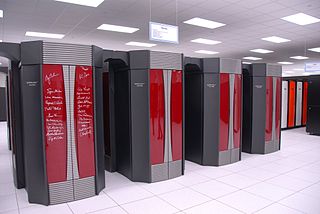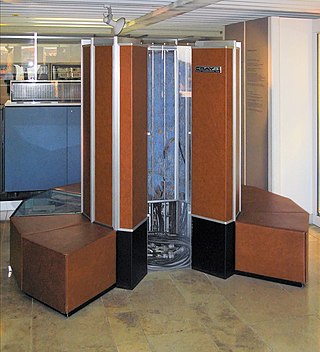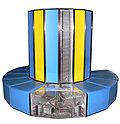
Silicon Graphics, Inc. was an American high-performance computing manufacturer, producing computer hardware and software. Founded in Mountain View, California in November 1981 by Jim Clark, its initial market was 3D graphics computer workstations, but its products, strategies and market positions developed significantly over time.

A supercomputer is a computer with a high level of performance as compared to a general-purpose computer. The performance of a supercomputer is commonly measured in floating-point operations per second (FLOPS) instead of million instructions per second (MIPS). Since 2017, there have existed supercomputers which can perform over 1017 FLOPS (a hundred quadrillion FLOPS, 100 petaFLOPS or 100 PFLOPS).
Cray Inc., a subsidiary of Hewlett Packard Enterprise, is an American supercomputer manufacturer headquartered in Seattle, Washington. It also manufactures systems for data storage and analytics. Several Cray supercomputer systems are listed in the TOP500, which ranks the most powerful supercomputers in the world.

ASCI Red was the first computer built under the Accelerated Strategic Computing Initiative (ASCI), the supercomputing initiative of the United States government created to help the maintenance of the United States nuclear arsenal after the 1992 moratorium on nuclear testing.
The T3D was Cray Research's first attempt at a massively parallel supercomputer architecture. Launched in 1993, it also marked Cray's first use of another company's microprocessor. The T3D consisted of between 32 and 2048 Processing Elements (PEs), each comprising a 150 MHz DEC Alpha 21064 (EV4) microprocessor and either 16 or 64 MB of DRAM. PEs were grouped in pairs, or nodes, which incorporated a 6-way processor interconnect switch. These switches had a peak bandwidth of 300 MB/second in each direction and were connected to form a three-dimensional torus network topology.

The NASA Advanced Supercomputing (NAS) Division is located at NASA Ames Research Center, Moffett Field in the heart of Silicon Valley in Mountain View, California. It has been the major supercomputing and modeling and simulation resource for NASA missions in aerodynamics, space exploration, studies in weather patterns and ocean currents, and space shuttle and aircraft design and development for almost forty years.
The Cray SV1 is a vector processor supercomputer from the Cray Research division of Silicon Graphics introduced in 1998. The SV1 has since been succeeded by the Cray X1 and X1E vector supercomputers. Like its predecessor, the Cray J90, the SV1 used CMOS processors, which lowered the cost of the system, and allowed the computer to be air-cooled. The SV1 was backwards compatible with J90 and Y-MP software, and ran the same UNIX-derived UNICOS operating system. The SV1 used Cray floating point representation, not the IEEE 754 floating point format used on the Cray T3E and some Cray T90 systems.

The Cray X1 is a non-uniform memory access, vector processor supercomputer manufactured and sold by Cray Inc. since 2003. The X1 is often described as the unification of the Cray T90, Cray SV1, and Cray T3E architectures into a single machine. The X1 shares the multistreaming processors, vector caches, and CMOS design of the SV1, the highly scalable distributed memory design of the T3E, and the high memory bandwidth and liquid cooling of the T90.

The Cray XT3 is a distributed memory massively parallel MIMD supercomputer designed by Cray Inc. with Sandia National Laboratories under the codename Red Storm. Cray turned the design into a commercial product in 2004. The XT3 derives much of its architecture from the previous Cray T3E system, and also from the Intel ASCI Red supercomputer.
HECToR was a British academic national supercomputer service funded by EPSRC, Natural Environment Research Council (NERC) and BBSRC for the UK academic community. The HECToR service was run by partners including EPCC, Science and Technology Facilities Council (STFC) and Numerical Algorithms Group (NAG).
The Challenge, code-named Eveready and Terminator, is a family of server computers and supercomputers developed and manufactured by Silicon Graphics in the early to mid-1990s that succeeded the earlier Power Series systems. The Challenge was later succeeded by the NUMAlink-based Origin 200 and Origin 2000 in 1996.

The SGI Origin 2000 is a family of mid-range and high-end server computers developed and manufactured by Silicon Graphics (SGI). They were introduced in 1996 to succeed the SGI Challenge and POWER Challenge. At the time of introduction, these ran the IRIX operating system, originally version 6.4 and later, 6.5. A variant of the Origin 2000 with graphics capability is known as the Onyx2. An entry-level variant based on the same architecture but with a different hardware implementation is known as the Origin 200. The Origin 2000 was succeeded by the Origin 3000 in July 2000, and was discontinued on June 30, 2002.

The Alpha 21064 is a microprocessor developed and fabricated by Digital Equipment Corporation that implemented the Alpha instruction set architecture (ISA). It was introduced as the DECchip 21064 before it was renamed in 1994. The 21064 is also known by its code name, EV4. It was announced in February 1992 with volume availability in September 1992. The 21064 was the first commercial implementation of the Alpha ISA, and the first microprocessor from Digital to be available commercially. It was succeeded by a derivative, the Alpha 21064A in October 1993. This last version was replaced by the Alpha 21164 in 1995.

The Alpha 21164, also known by its code name, EV5, is a microprocessor developed and fabricated by Digital Equipment Corporation that implemented the Alpha instruction set architecture (ISA). It was introduced in January 1995, succeeding the Alpha 21064A as Digital's flagship microprocessor. It was succeeded by the Alpha 21264 in 1998.
The National Center for Computational Sciences (NCCS) is a United States Department of Energy (DOE) Leadership Computing Facility that houses the Oak Ridge Leadership Computing Facility (OLCF), a DOE Office of Science User Facility charged with helping researchers solve challenging scientific problems of global interest with a combination of leading high-performance computing (HPC) resources and international expertise in scientific computing.
Shaheen is the name of a series of supercomputers owned and operated by King Abdullah University of Science and Technology (KAUST), Saudi Arabia. Shaheen is named after the Peregrine Falcon. The most recent model, Shaheen II, is the largest and most powerful supercomputer in the Middle East.

The term supercomputing arose in the late 1920s in the United States in response to the IBM tabulators at Columbia University. The CDC 6600, released in 1964, is sometimes considered the first supercomputer. However, some earlier computers were considered supercomputers for their day such as the 1960 UNIVAC LARC, the IBM 7030 Stretch, and the Manchester Atlas, both in 1962—all of which were of comparable power; and the 1954 IBM NORC.

Several centers for supercomputing exist across Europe, and distributed access to them is coordinated by European initiatives to facilitate high-performance computing. One such initiative, the HPC Europa project, fits within the Distributed European Infrastructure for Supercomputing Applications (DEISA), which was formed in 2002 as a consortium of eleven supercomputing centers from seven European countries. Operating within the CORDIS framework, HPC Europa aims to provide access to supercomputers across Europe.
The Cray XK6 made by Cray is an enhanced version of the Cray XE6 supercomputer, announced in May 2011. The XK6 uses the same "blade" architecture of the XE6, with each XK6 blade comprising four compute "nodes". Each node consists of a 16-core AMD Opteron 6200 processor with 16 or 32 GB of DDR3 RAM and an Nvidia Tesla X2090 GPGPU with 6 GB of GDDR5 RAM, the two connected via PCI Express 2.0. Two Gemini router ASICs are shared between the nodes on a blade, providing a 3-dimensional torus network topology between nodes. This means that it has 576 GB of Graphics memory and over 1500 CPU cores, several orders of magnitude more powerful than the best publicly available computer on the market.

Approaches to supercomputer architecture have taken dramatic turns since the earliest systems were introduced in the 1960s. Early supercomputer architectures pioneered by Seymour Cray relied on compact innovative designs and local parallelism to achieve superior computational peak performance. However, in time the demand for increased computational power ushered in the age of massively parallel systems.












